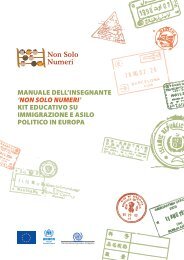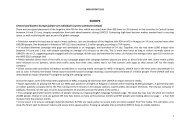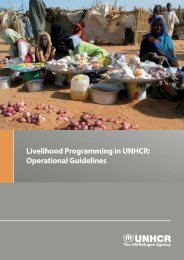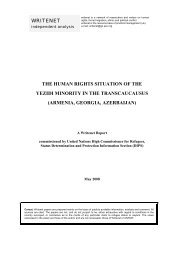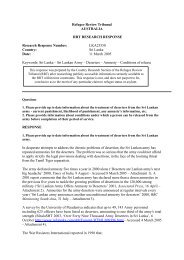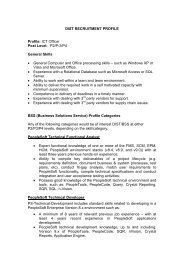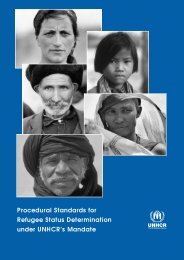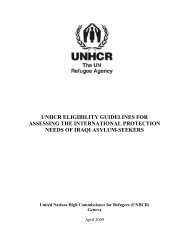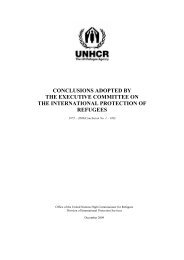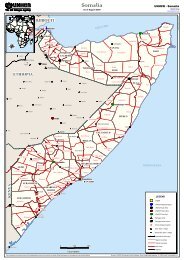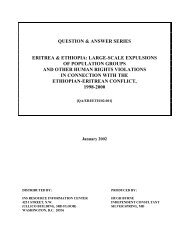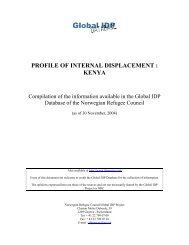UNHCR's ELIGIBILITY GUIDELINES FOR ASSESSING THE ...
UNHCR's ELIGIBILITY GUIDELINES FOR ASSESSING THE ...
UNHCR's ELIGIBILITY GUIDELINES FOR ASSESSING THE ...
Create successful ePaper yourself
Turn your PDF publications into a flip-book with our unique Google optimized e-Paper software.
isk of detention and serious mistreatment for remaining family members. There are<br />
allegations of collective punishment against men and women, such as rape and other forms<br />
of torture, in cases where family members were wanted by the authorities but had left the<br />
country. 782 In other cases, legislation provided for severe punishment of those that refused<br />
to carry out certain acts. For example, medical doctors who refused to carry out ear<br />
amputations and tattooing of army deserters or evaders in line with RCC Decree 115 of 25<br />
of 25 August 1994 were subject to severe punishment. 783<br />
c) Proportionality Considerations<br />
If it is established that an applicant incurred individual responsibility for acts within the<br />
scope of Article 1F, the final step in the exclusion analysis consists of weighing the<br />
seriousness of the acts in question against the consequences of exclusion for the individual<br />
concerned. 784<br />
d) Consequences of Exclusion<br />
Persons to whom an exclusion clause applies are not eligible for refugee status. They<br />
cannot benefit from international protection under the 1951 Convention, nor under<br />
UNHCR’s mandate. However, they may still be protected against return to a country where<br />
they are at risk of ill-treatment by virtue of other international instruments. 785<br />
It is important to recall, however, that family members of excluded individuals are not<br />
automatically excluded as well. Their claim to refugee status needs to be examined on an<br />
individual basis, and in light of their own situation. Family members may qualify for<br />
refugee status even if their fear of persecution results from their relationship to the excluded<br />
relative. Family members are only excluded if there are serious reasons for considering that<br />
they are also individually responsible for excludable crimes. Where family members have<br />
been recognized as refugees, however, the excluded applicant cannot benefit from the right<br />
to family unity to secure protection or assistance as a refugee. 786<br />
782 UNHCHR, Special Rapporteur of the Commission on Human Rights on the situation of human rights in<br />
Iraq, The Situation of Human Rights in Iraq, A/65/340, 13 September 2001, p. 6-7,<br />
http://www.unhchr.ch/Huridocda/Huridoca.nsf/0/8e85ad0aea73e88bc1256af10051cade/$FILE/N0153521.pdf<br />
; ibidem, A/55/294, 14 August 2000, p. 7, http://www.unhchr.ch/Huridocda/Huridoca.nsf/0/81fd25017cae<br />
76c4c125697a0045cd36/$FILE/N0060774.pdf.<br />
783 UNHCHR, Special Rapporteur of the Commission on Human Rights on the situation of human rights in<br />
Iraq, The Situation of Human Rights in Iraq, A/49/651, para. 53-54 and 65, 8 November 1994,<br />
http://www.unhchr.ch/Huridocda/Huridoca.nsf/TestFrame/4ca4ae2431b4edb880256708005c71fa?Opendocu<br />
ment.<br />
784 Ibidem, para. 76-78.<br />
785 See UNHCR, Guidelines on International Protection No. 5: Application of the Exclusion Clauses: Article<br />
1F of the 1951 Convention relating to the Status of Refugees, HCR/GIP/03/05, 4 September 2003, para. 9,<br />
available in UNHCR’s Refworld at: http://www.unhcr.org/cgi-bin/texis/vtx/refworld/rwmain?docid=<br />
3f5857684, and UNHCR’s Background Note on Exclusion, see above footnote 741, para. 21-22.<br />
786 See UNHCR, Background Note on Exclusion, see above footnote 741, at paragraphs 94-95.<br />
150



